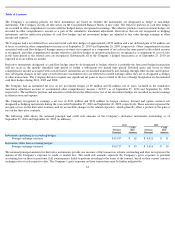Apple 2010 Annual Report Download - page 54
Download and view the complete annual report
Please find page 54 of the 2010 Apple annual report below. You can navigate through the pages in the report by either clicking on the pages listed below, or by using the keyword search tool below to find specific information within the annual report.
Table of Contents
the sale of these devices at the time of their sale. Additionally, the Company is required to estimate a standalone selling price for the unspecified
software upgrade rights included with the sale of these devices and recognizes that amount ratably over the 24-
month estimated life of the related
hardware device.
Refer to the “Explanatory Note” and Note 2, “Retrospective Adoption of New Accounting Principles” in the 2009 Form 10-
K for additional
information on the impact of adoption of the new accounting principles, which sections are incorporated herein by reference.
Revenue Recognition
Net sales consist primarily of revenue from the sale of hardware, software, digital content and applications, peripherals, and service and support
contracts. The Company recognizes revenue when persuasive evidence of an arrangement exists, delivery has occurred, the sales price is fixed or
determinable, and collection is probable. Product is considered delivered to the customer once it has been shipped and title and risk of loss have
been transferred. For most of the Company’
s product sales, these criteria are met at the time the product is shipped. For online sales to
individuals, for some sales to education customers in the U.S., and for certain other sales, the Company defers revenue until the customer
receives the product because the Company legally retains a portion of the risk of loss on these sales during transit. The Company recognizes
revenue from the sale of hardware products (e.g., Macs, iPhones, iPads, iPods and peripherals), software bundled with hardware that is essential
to the functionality of the hardware, and third-
party digital content sold on the iTunes Store in accordance with general revenue recognition
accounting guidance. The Company recognizes revenue in accordance with industry specific software accounting guidance for the following
types of sales transactions: (i) standalone sales of software products, (ii) sales of software upgrades and (iii) sales of software bundled with
hardware not essential to the functionality of the hardware.
The Company sells software and peripheral products obtained from other companies. The Company generally establishes its own pricing and
retains related inventory risk, is the primary obligor in sales transactions with its customers, and assumes the credit risk for amounts billed to its
customers. Accordingly, the Company generally recognizes revenue for the sale of products obtained from other companies based on the gross
amount billed. For certain sales made through the iTunes Store, including sales of third-party software applications for the Company’
s iOS
devices, the Company is not the primary obligor to users of the software, and third-
party developers determine the selling price of their software.
Therefore, the Company accounts for such sales on a net basis by recognizing only the commission it retains from each sale and including that
commission in net sales in the Consolidated Statements of Operations. The portion of the sales price paid by users that is remitted by the
Company to third-party developers is not reflected in the Company’s Consolidated Statement of Operations.
The Company records deferred revenue when it receives payments in advance of the delivery of products or the performance of services. This
includes amounts that have been deferred related to embedded unspecified and specified software upgrades rights. The Company sells gift cards
redeemable at its retail and online stores, and also sells gift cards redeemable on the iTunes Store for the purchase of content and software. The
Company records deferred revenue upon the sale of the card, which is relieved upon redemption of the card by the customer. Revenue from
AppleCare service and support contracts is deferred and recognized ratably over the service coverage periods. AppleCare service and support
contracts typically include extended phone support, repair services, web-
based support resources and diagnostic tools offered under the
Company’s standard limited warranty.
The Company records reductions to revenue for estimated commitments related to price protection and for customer incentive programs,
including reseller and end-user rebates, and other sales programs and volume-
based incentives. The estimated cost of these programs is
recognized in the period the Company has sold the product and committed to a plan. The Company also records reductions to revenue for
expected future product returns based on the Company’
s historical experience. Revenue is recorded net of taxes collected from customers that
are remitted to governmental authorities, with the collected taxes recorded as current liabilities until remitted to the relevant government
authority.
51
























